By 1970, the fourth generation (1965-1970) of Chevrolet’s all-time best-selling car, the B-body Caprice, Impala, BelAir, and Biscayne had reached the end of the line. And things had changed a bit since gen-four was introduced for model year 1965. The Impala was still the go-to model in Chevrolet’s full-size line-up but consumers had many other choices too. Our subject car today is a 1970 Impala Custom Coupe and it looks to be in great shape. It’s located in Bremen, Georgia and is available, here on eBay for a starting bid of $17,500, with a BIN price of $23,500.
Several notable changes occurred with the introduction of the ’70 big cars, including the Impala. There was no longer an Impala SS, bucket seats, a center console, and a four-speed manual transmission were all now consigned to history. It was the first year for the big 454 CI, Mark IV engine as well as the first year for the seriously stretched and stroked 400 CI, small-block motor. Other changes included standard front disc brakes on the Impala Custom and Caprice, as well as standard 15-inch wheels on all B-Body cars, an improvement that should have occurred years before. How did the Impala do in ’70? The total production number was about 774K copies (including station wagons); a pretty stout number but a big drop from gen-four’s initial year of 1965 when 1,046,000 units found new homes.
This 110K mile example is a survivor and is listed as a one-owner car, though the individual selling it isn’t the original owner. It appears to be in very sound shape and is still wearing its original Classic White lacquer finish and black vinyl top. It is really an amazing feat as Chevies of this era were equipped with “flush-and-dry” rocker panels which were more like “flood-and-fail” as water would get trapped in the lower fenders and rot right through. I owned a ’69, which is essentially the same car, and the rust was noticeable at age four and had gone clean through by age eight – and mine was one of the thousands that all did the same thing. Considering the condition of this Impala, I would say it has been garage kept, and of course, being domiciled in the Peach State has been an advantage to its long-term well-being. The P02 wheel covers don’t appear to be originals as the born-with caps are in the trunk, nevertheless, they are a nice addition. The white-letter tires are a matter of taste, they seem better suited to a Camaro or a Corvette. Of note, this Impala is an “Impala Custom”, which features a formal roofline and a concave rear window, as opposed to an Impala Sport Coupe which had the ’60s style sloping roofline. Introduced in 1968, the Custom quickly became the preferred coupe.
Under the hood, is Chevrolet’s new for 1970, 265 gross HP, 400 CI, small-block, V8 engine. This motor was known as the 400 “Turbo-Fire” to differentiate it from the 400 CI “Turbo-Jet” big-block engine, also new in ’70. The 400 Turbo-Jet was actually a 402 CI, being the old 396 that had been slightly enlarged. Chevrolet never used the 402 moniker, preferring 400 or 396 depending on the vehicle of installation. Nevertheless, it’s irrelevant in this case as the 400 Turbo-Jet wasn’t available in the ’70 Impala and it was discontinued entirely after the ’72 model year. The transmission employed is the typical Turbo-Hydramatic 350, three-speed automatic gearbox. Regarding this Impala’s operating attributes, the seller states, “It has new mufflers, new gas tank, and new water pump. This car drives straight and you can cruise in it at 75 with no problem“.
Here’s an obscure factoid, this Impala was purchased under the “Impala 400 Sale” promotion. The way that you can tell is that according to the included image of the window sticker, the 400 CI engine and dual exhaust system were no charge items when a market basket of other options was ordered. I recall seeing a TV ad at the end of a Bonanza episode in the summer of ’70 where actor Lorne Greene (Ben Cartright) was pushing this promotion.
The interior has done quite well over the last half a century. The seller mentions that the front seat has been recovered but the rest is original. The only divet appears to be a crack in the dash pad and some scruffy-looking armrest bases. Still in place is the original clock and Delco radio, always good to find. The seller mention that the Four-Season A/C system is inoperative, it has probably developed a leak and lost all of its R-12 refrigerant. The Four-Season systems are not complicated and a Frigidaire A6 style compressor can still be newly obtained; R-12, however, is another matter.
Impalas of this era are held in high regard today because they are a fond memory and so different from anything else that is currently offered. But in 1970, there was a gen-four Impala on every street corner in every city or town in America. This is a nice car, but it’s really nothing special. As to how high a regard this example will be held, I doubt $23,500 worth of it. The pictorial in the listing is excellent, be sure to check out all of the images and then let me know, priced right, or maybe not?

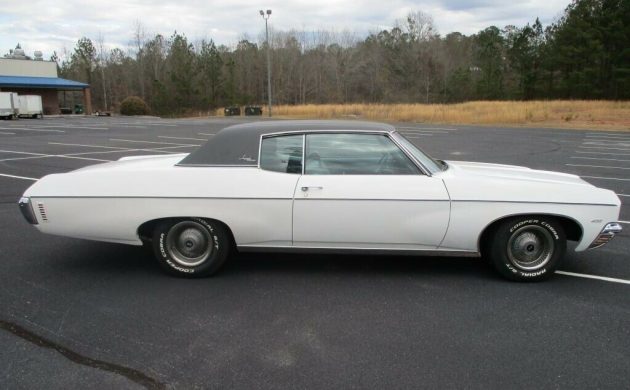

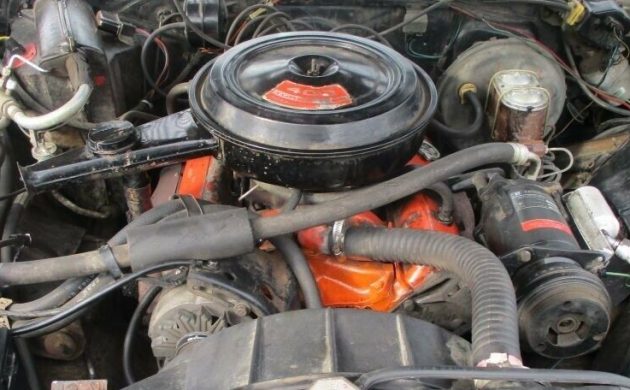
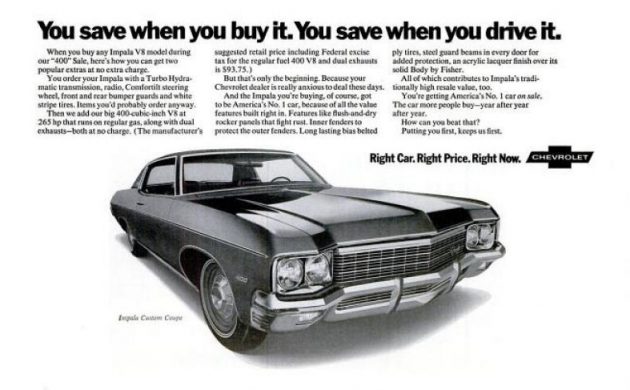
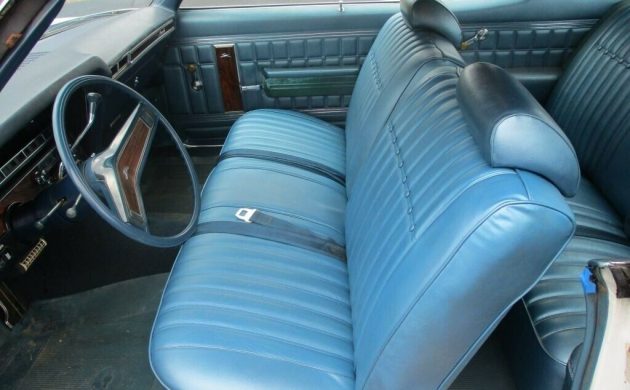
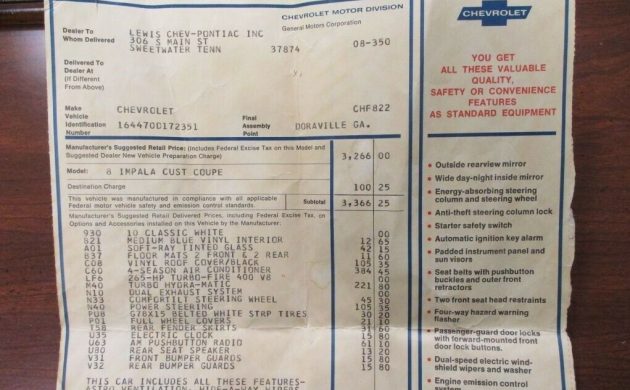


Had one of these for my 2ND car when I was in college, great car! It would hold a lot of ppl!
That does not look like big bock to me its a 1st year SBC 400
Correct, it’s a 400 CI small-block engine.
JO
Nice write-up Jim. I think you nailed most of things I would have mentioned: highest production GM, 400 sbc, same chassis as ’65, PO2 turbines, etc.
As for flush and dry rockers, well, the rockers never rot out on these. But yeah, that lower fender is a problem.
One place you goofed was the transmission. 400 sbc got a TH400 (m40) and a 12-bolt with four control arms. This being an Imp received 2.73. If it were a ’70 Caprice (like mine), would have 2.56. And 2.56 cruises just fine down the interstate. Turnpike Cruiser baby.
As for the price, yeah a bit high considering it’s all original. I’d expect about $23 for my Cap, but it has been restored with lots of subtle improvements: HD suspension, fast steering, 134 AC, hands free OE look radio, OE reupholster is quilted nylon, OE15x7 rallies, rebuilt 400 w/dart Quad Hei dual 2.25. Gets 22+ on the pike, about 12 in town. Oh, almost forgot – the clock converted to quartz. Everything works!
bry593:
Thanks for the compliment. One thing, if you check the underside images of this Impala you can see that it has a Turbo 350, not a 400, the pan is a dead giveaway. The window sticker does refer to it as an M40, but Chevrolet used M40 as the designation for both in this era. It was later on that the RPO M38 was used to denote the Turbo 350.
It does have a 12 bolt.
Thx again,
JO
My best friend from high school Mom had one just like this except had a black interior and a 350 engine. Very nice car that he wasn’t allowed to drive very often!
About 25% too proud.
This is a nice car, with all the right options, though I don’t know enough about these cars to say if the price is realistic.
I never understood the reason for the 2 bbl 400 small block. It was only 15 more hp than the 2 bbl 350, but was 35 less than the 350 4 bbl. Not only was the 350 4 bbl faster, but with it’s spread bore Q-Jet, it got similar mileage.
Torque…and lots of it. There was a large weight difference between the big block and small block (about 100 lbs) as well.
While the big block 396/402 certainly did produce more torque that the 350, the small block 400 2 bbl this car has, only produced slightly more torque (15-20 ft lbs?) than the 350 4 bbl. It was hardly enough to make the 400 quicker, and since the 350’s Q-Jet was a fairly thrifty carb (if you kept your foot out of it), the 400 didn’t get better mileage either.
So as I said before, I never really understood GM’s thinking behind offering the “small block” 400. The 70’s 400 small block was one of the very few times that Chevrolet produced a larger displacement engine, that had less output than it’s smaller counterparts.
One of the reasons was the imminent death of the big-block in passenger cars. 1969 only saw a 396 BBC with 2bbl and an identical 265 hp and torque rating and it was both heavy and inefficient. GM needed something else to fill that role, and the 400 was born. These engines were supposed to be for casual motoring and towing…not peak dragstrip performance. Even though the 350 had only slightly less peak torque, that torque was not available until 3200 rpm. Meanwhile, the 400 SB made 400 lb-ft at only 2400 rpm. Combine that curve with a 100 lb weight loss and a common architecture that would outlive the BB in passenger cars by 25 more years, it was thought to be savvy move by GM. However, the siamesed cylinder bores of the 400 SB were just the beginning of GM’s early 1970’s powertrain woes.
jwzg:
You nailed it with the issue of the siamese cylinder bores on the 400. During my time working at a Chevrolet dealership in 1974, I saw more than a few 400s with blown head gaskets. It seems that they would go between the number 3 and 5 or 4 and 6 cylinders as a result of overheating and warpage. It’s silly really when you think about it, the 400 was intended for a big, heavy car, one that might pull a trailer or boat in hot summer weather, A/C running and loaded down with the family and luggage – the very thing that tested the 400’s durability.
And it was, as you state, a portend of things to come.
JO
It was a marketing thing, Ford had a 390-2bbl, Plymouth a 383-2 bbl, and Pontiac a 400-2bbl. Chevrolet tried to compete in ’69 with a one-year-only, low compression 396-2bbl (RPO L66) but it was a heavy and expensive dud.
JO
I bought one in 1996 in this condition for $150.
No bucket seats or manual trans avail in any full size chevy in ’70?!
Incredible with such major changes for ’70, this was for only 1 yr, tho i bet if the gas crisis later could have been foreseen, no way Chevy would make those silly bloated ’71-76 models.
I’m guessing this ’70 is maybe 100 lbs lighter compared to the loop front bumper ’69 model.
A three-speed manual, via a column shift, was still available, but no four-speed manual floor shift.
JO
Bored to the water was the saying when I worked at a Chevy dealer.
I own an all original DAY ONE Survivor.. FULL Documentation
1970 Chevrolet Impala w/ 350cid (265hp) 2brl carb, 350 trans.. get 18.9 mpg
All documents include:
Original Dealer Order Form
Original Dealer Delivery Ticket
Original Protect O Plate
Original Window Sticker
Original Freight delivery ticket from Janesville, WS factory
Two sets of original keys on 50 yr old Original Desler key chains
Bill Olson Chevrolet
Albert Lea, MN
My Mom had a Indian Red convertible with black interior and Corvette Rallys Beautiful Machine
400 Sale? Explains how this car is optioned the way it is. lol And the no charge for the engine upgrade. Most Impala’s of this age that I have seen don’t even have AC, which was a big time luxury back then.
Maybe where YOU live, but by the late 60s, most full-size cars even here in rainy Oregon had factory AC. My first was a factory ordered 68 Impala, and my second was an Impala Custom like this but in dark green.
I have only seen two 2bbl 400SBCs, but I think there was a 400 SBC which had a four barrel.
We turned one of these siamesed cylinder bores 400s 2bbls into a 406 street engine. A Chevrolet performance high rise intake and 750 Holley using Dart heads produced 450 horsepower with 490 foot pounds of torque on the dyno with a cam that wasn’t too radical. Didn’t have any trouble with it.
There was a 4bbl version.
In 89′ I needed a motor for my truck and came a cross a 70′ wagon, Caprice(?) w/40k on it. It was clear that it had always been the original factory 4bbl
I had a 78′ Camper Special W/ 411’s,and with that 400 sbc/ headers and a rebuilt TH350 from a car, it was actually one of the fastest vehicle’s I’ve owned and I’ve had some good ones.
Some kid and his girlfriend in a 87 IROC thought he was gonna smoke that rusty truck at the light.
The look on his face after a truck with ladders and lumber in the bed pulled away from him was priceless
My mom had a 65 Chevy that was stolen, so my dad replaced it with 69. It was the same as this one; white body, black vinyl roof. It had a 350, auto, bucket seats and a full console. It was a cruiser. We named it the Galactica.
I see people commenting that this car is overpriced even though it is a nice one and commenting on how the rusted out ’61 wagon on here is a steal?
Not sure of the train of thought but myself, I would drop the money on this one.
In the early eighties,I was on a swim team,and about 15 or 16 of us would pile in the coach’s 70 4-door impala to go to meets,fun times,it would creak and moan making turns…lol.
The reason GM didn’t sell as many Impalas in 1970 was because the UAW was on strike at GM in 1970.
That GM strike started on September 14, 1970 and it looks like the 1970 models were not being made then. I think the some of the lines like the Chevelles shutdown at the end of July 1970.
Exactly right. 71 production had already begun, but few new 71 cars were yet at the dealerships. The strike would have had no affect on 70 model year production. However, it might’ve helped dealers clear out the 70 leftover stock more quickly.
Pretty nice car but way too expensive. This car would be a real dog, I had a 69 with a 396 in it and it was a dog.
Admittedly, I haven’t ever gone looking for a ’70 Chevy Impala, but I seriously doubt very many were built like the one my Mom bought! It was an Impala, but it was optioned like a very base Biscayne! NO power steering, brakes, windows, door locks, nothing! Powerglide transmission, dog dish hubcaps. Mom bought it from Beatty Chevrolet in Knoxville Tn, brand new. A first for them. I had the original window sticker for it at one time. Not sure what happened to it. The car ended up in Florida at my brothers. Just a few short miles from the ocean. It ended up, a rusty relic in a junkyard.
70-71 400sb had 4 bolt mains. You can tell a 400sb from the notch in the harmonic balancer being that it was an externally balanced motor. Back in the day, all you had to do was slap a good set of camelback heads on these, put in a decent cam, intake, and carburetor and you had one potent engine. Just don’t rev it past 6500 rpm. These engines had tons of torque. With just a few simple basic mods, the 400sb made for one of the best engines for street action, especially stoplight to stoplight.
This looks to be a really nice well cared for ’70 Impala.
My mother’s ’70 Caprice 2 door had a 350 engine with Rochester Quadrajet four barrel carburetor. She loved that car. She and my father had to go out and she specifically warned me not to drive her car following a snow with accompanying sleet that had blanketed the area two days earlier. I was 16 years of age, cocky and over confident and foolishly decided to drive it down to the local Seven Eleven to get some milk. I made it to the store just fine, but driving back as I went into a slight curve to the left where there was some undeveloped level land on the right, the car kept tracking straight and headed right for the only big honking tree on the property. I closed my eyes and braced for the impact, but it never came. Turns out I stopped about two feet from the tree which looked like six inches peering through the windshield. Talk about the pucker factor coming into play. I got the car home safely making sure to drive precisely in the same tracks I left backing out of the driveway. I thought I was home free until shortly after my parents returned I heard my mother exclaim “Where did the milk come from”? Busted and grounded for two weeks!
RoughDiamond:
What a great story! I think we all had a similar escapade during our youthful exuberance.
Thx for sharing!
JO
My dad bought a 70 new ,red with black vinyl top me & my sister both learned to drive with it ,was a great car !Lots of power i cant believe we did’nt wreck it !
Hi. I have a 1970 convertible with 400ssb and th400. I’m wondering how many were equiped this way? Indian red. Red interior white top
66kmiles
I have a 70 Impala Convertable Red on Red 300/350
I hear its a Rare car only 9,562 made , why so little convertables ?
If any one who has a 70 impala wants to meet up in New Jersey let me know
For 1970, these Chevies got this classier front end which made it look more expensive & shorter than a ’67-69! What a big mistake GM made switching to the ’71-76 monstrous heavier body style. This body style should have lasted thru ’76 IMO & less gas would have been used. lol
We had two 400’s and the first one had 4 bolt mains. The second one had 2 bolt mains which our engine builder turned into four bolt mains using billet caps. He said these modified 2 bolt mains were actually stronger than the original 4 bolt mains.
Our 406 was very strong with a roller cam and Dart heads. We didn’t have any trouble with the siamesed cylinder bores. The 400s were very scarce back in 1991 and I imagine most of them have been crushed a long time ago.